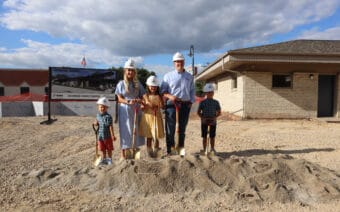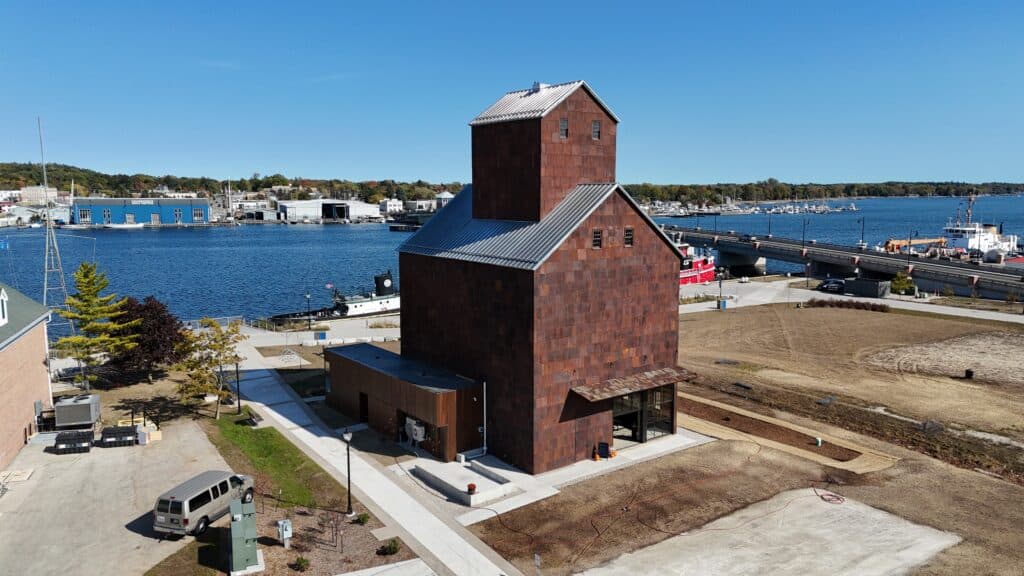
July 14, 2025
DOOR COUNTY – “Once it’s gone, it’s gone” was one of many calls to action in the effort to save Door County’s historic Tewels and Brandeis Granary.
After a long and tumultuous journey, Nicole Matson – executive director of the Sturgeon Bay Historical Society Foundation – said the Door County Granary stands tall, restored and open for visitors at 72 E. Locust St. in Sturgeon Bay.
The granary now known as the Door County Granary, Matson said, is the last remaining structure of the turn-of-the-20th-century agricultural economy that transformed Sturgeon Bay into a year-round community.
She said it is also one of the last remaining wooden grain elevators located on the Great Lakes and the only interpreted wooden port grain elevator on the Great Lakes.
Efforts to restore both the 1901 granary building and its presence on Sturgeon Bay’s west-side waterfront, Matson said, seek to honor its heritage, capitalize on waterfront development, serve as a destination for education, research, creativity and, ultimately, cultivate community.
“The building itself and its function of distributing food [represents] the beginning of wholesale food distribution throughout the U.S.,” she said. “There is significance for that infrastructure in moving food via the Great Lakes and railway, supporting farm families, building their businesses and [boosting] the economy here.”
More specifically, Matson said the restored granary highlights an American invention and a significant piece of the U.S.’s economic evolution through its utilitarian architecture amid Sturgeon Bay’s West Waterfront Park and Promenade.
But, she said it’s equally what’s inside that counts, as the granary houses many memories and stories within its walls.
The cultivation of community is something Matson said has been a part of the granary for its entire existence.
As it brought together shipping and the railway with nearby farmers’ harvests, she said it also became part of farmers’ everyday lives and a social destination – as a granary is purported to be one of the first locations for the landline telephone.
“The grain elevator made us an agricultural and political powerhouse,” she said. “Our products went to San Francisco in 1906 after the earthquake, and to Europe after World War I – it was the strongest structure in a town. But [the granary] also was a commercial and social place to gather – it’s hard to overstate its role.”
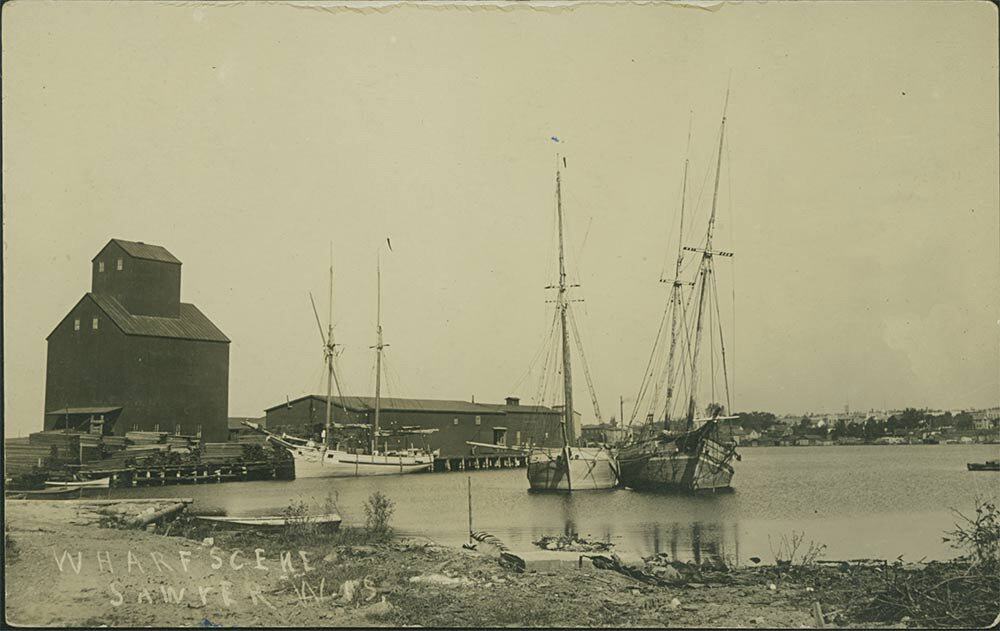
An excerpt from a 1902 local newspaper, Matson said, described it best when it noted, “the liveliest place out of the business streets is down at the elevator where hundreds of teams are found daily.”
Today, Matson said the former Tewels and Brandeis Granary has reopened as a community hub once more, serving as a three-season public gathering venue.
And yet, she said the granary’s second act almost didn’t happen.
How it got its second chance
Matson said the Sturgeon Bay Historical Society Foundation, which owns and operates the granary, was established as a result of another preservation project – one to save the Michigan Street Steel Bridge.
Citizens involved in that effort, she said, realized the need to preserve other Door County historic sites, including the granary.
“That’s how the Sturgeon Bay Historical Society Foundation was started,” she said.
At about the same time – in 2015 – Matson said the City of Sturgeon Bay had initial plans to preserve the granary and make it part of a redevelopment on the waterfront.
To that end, she said the city removed several co-op buildings, performed a study of the building and deemed it a good site for redevelopment.
Matson said things shifted in 2017-18 when the city placed a raze order on the granary – which prompted the historical society to “go full force with advocacy.”
She said that included securing a $1.25 million donation from an anonymous donor to preserve the granary.
Even though the city chose to proceed with the raze order, Matson said the historical society and citizens persisted.
“The historical society figured out a last-ditch effort to save the building,” she said.
Matson said community members turned out to city council meetings and other forums, sharing their “why” for preserving and restoring the granary.
One of those people, Matson said, was Don Rudolph – whose grandfather, Karl Rudolph, moved to Sevastopol in 1899 to find improved farmland and better markets for his farm products, did business at the Tewels and Brandeis Granary, followed by his father, Edgar Rudolph with Stanley Brandeis and later the Door County Cooperative in the same location.
Matson said Don followed in his grandfather’s and father’s footsteps until the Door County Cooperative moved out of town.
Don’s statement to the Sturgeon Bay Council in 2018, Matson said, speaks volumes to the generations-long legacy the granary left.
Don wrote: “The granary is most likely the last link to Sturgeon Bay’s agricultural past. At one time, Sturgeon Bay had blacksmith shops, harness shops, implement dealers, food processing facilities, a feed processing plant and various warehouses for storing ag products. The granary is all that is left. It would be a most-fitting memorial to honor the hard work and risk-taking our ancestors undertook to get us where we are today.”
Fortunately, Matson said the historical society and the Citizens for the Bridge were ultimately able to purchase the building and move it across the bridge to save it intact.
She said the society had raised another $1.25 million in private donations and funds from small family foundations and grants, so it came to the table with $2.5 million.
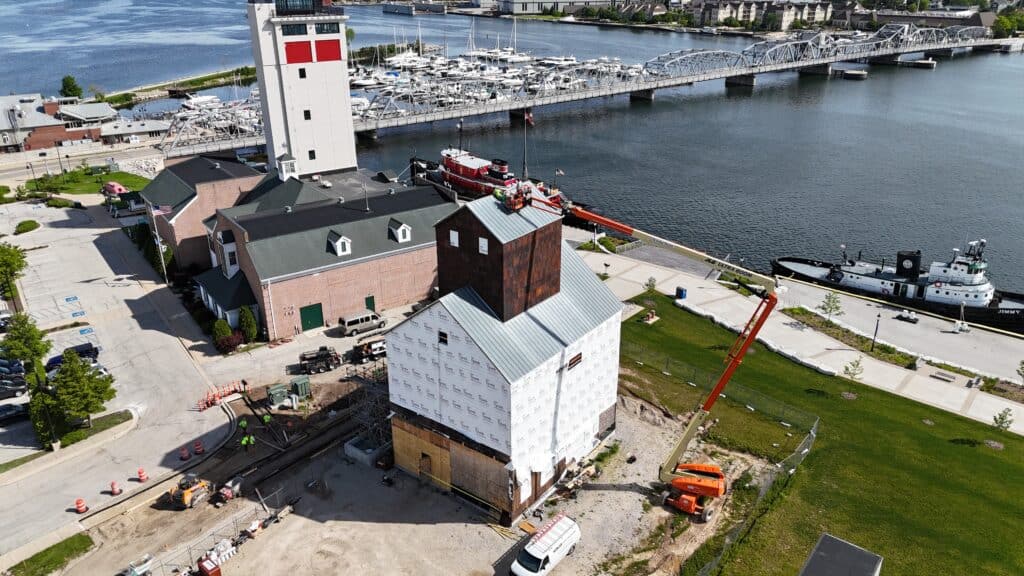
In addition, Matson said the group obtained a $3.3 million U.S. Department of Agriculture Rural Development Community Facilities Grant.
At the end of the day, Matson said the group was on a mission to return the granary to its rightful place, where it was originally built, albeit no longer on a dock.
“Being on a dock really served its function as shipping on the Great Lakes, and schooners would come up and receive grain and then distribute it via the Great Lakes and on a railroad spur,” she said. “The canal had opened, the railroad had come in and industry was happening, so moving it back to the original location was important to the overall story and had historical significance, including being placed on the National Register of Historic Places.”
Matson said the whole effort is a testament to the power of a small but mighty group of people on a mission.
She said there are and were many volunteers, board members, former board presidents, donors and others who have contributed time, talent and treasure to the cause.
“We have some great people on the board that continue [the] advocacy and mission forward as we move forward with this process,” she said. “Every single person has some passion for this building.”
Restoration becomes reality
Kelly Catarozoli, operations manager of the Door County Granary, said the restoration required moving the granary as it existed – from the ceiling of the first floor to the top of the building – to its west-side site and then putting the first floor back together with a new foundation, which required 51 new pilings in the lakebed.
“From the ceiling up is intact, and it will be exciting to get people all the way to the top and be able to see the bins and the machine and how everything works [in the future],” she said.
In addition to performing a thorough cleaning, Catarozoli said the granary needed siding to address the gaps where it had been torn off and exposed the bare wood.
As luck would have it, she said, patina siding from the Globe Grain Elevator in Superior was available and fit right in.
Catarozoli said the restoration of the workhouse – the first floor of a granary – was complemented by a new addition to the building that includes a prep kitchen, public restrooms and a stair tower.
What’s envisioned for the space, Catarozoli said, are holiday markets, weddings, family and class reunions, lectures and other classes, pop-up art installations and theater events.
The first floor, she said, sets the stage with a grand entrance to the museum.
Matson said she sees it as an opportunity to tell the stories of the granary, as well as serve as a gathering space for the community, situated right in a public park on state public land.
“It’s about the public enjoying and having a place on the waterfront to just be, enjoy, have coffee or hang out with friends in a publicly accessible way,” she said.
And yet, Catarozoli said it is far more than that.
“It’s a museum in the fact that the building itself is a museum, and you can’t have an event in it without the experience,” she said. “We have the flexibility to have people stroll through and organizations host events here, and we get to do our own programming, which is wonderful. Our hope is that it continues to grow as a community hub again.”
Catarozoli said the granary is more than just a building – “it’s a learning experience about the technology that existed and how it was so significant to the infrastructure of moving food around at the time.”
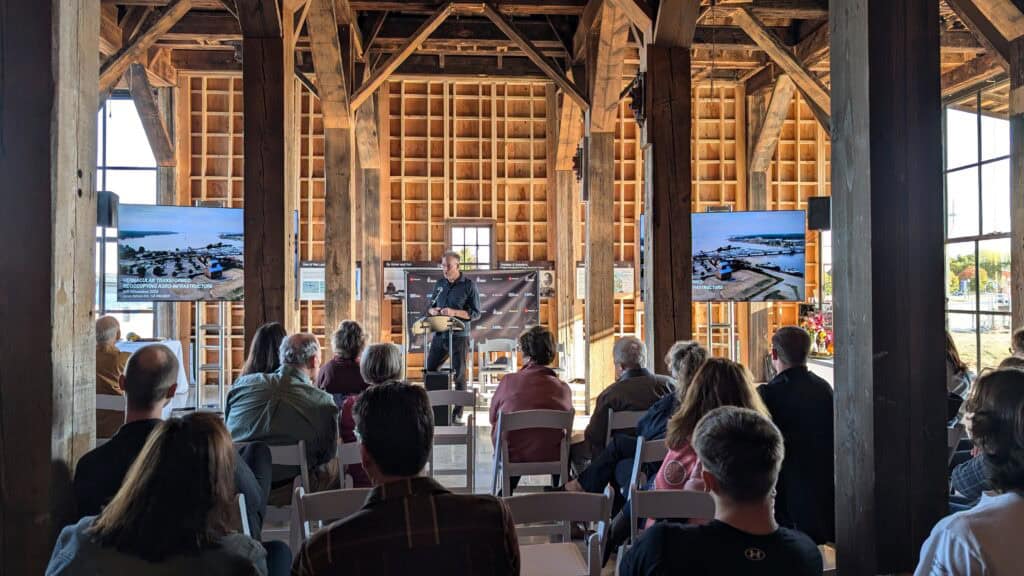
“You can touch it – it’s not like a picture on the wall at a regular museum,” she said. “You can stand at the desk and sign your name where people got their receipts for 125 years.”
Matson said the plan is for the granary to work in tandem with other waterfront events, activities and partners, whether that’s Destination Sturgeon Bay, the Door County Maritime Museum, visiting Tall Ships in late July and early August and other festivals and events to attract even more visitors to Sturgeon Bay.
“We have this unique, historic facility open to the public that can enhance the guest experience for these events,” she said. “This space is in a renaissance with redevelopment. There is such beauty here between the bridges and tugs and the nexus of so many trails where the Ahnapee and Ice Age Trails connect.”
Reaching new heights
Matson said the historical society is aiming to add another phase to the granary project to renovate and restore the upper-level experience – which she likens to a lighthouse but being immersed in an agricultural machine.
She said there are so many intact grain storage bins and chutes and mechanics to the grain elevator that phase three can help to bring to life.
When it was fully functioning, Matson said the granary’s elevator stored grains in a vertical fashion.
The lower floor, she said, was the heart of the granary and had the “boot” into which farmers dumped their grain as well as a vertical belt-and-buckle conveyor that lifted the grain to the head house or cupola.
From there, Matson said the spouts poured the grain into a series of walled bins for bulk storage.
An opening at the bottom of each bin, she said, allowed the grain to empty into freight boats, trucks or railroad cars.
“We’re looking forward to bringing visitors into a new recreational experience inside the artifact,” Matson said.
She said Jeffrey Beane of Beane Engineering, a Sturgeon Bay High School graduate and structural engineer; LA DALLMAN Architects, the lead architectural firm; and Greenfire Management Services, the general contractor, will continue to be instrumental in bringing their vision to life.
“We need to continue to work together to get to the top,” Matson said. “We have goals for the summer, and if we can meet those, we’d begin construction in November with hopes of opening in May for next season.”
 CVTC students brush up on skills in new dental simulation lab
CVTC students brush up on skills in new dental simulation lab Powering forward with solar energy
Powering forward with solar energy






